Modern Service Industry
“Net Zero Carbon” Circular Industry Park Project of Jilin City
1. Introduction to the Project
1.1 Project background
1.1.1 Product introduction
This project covers an area of 1 million square meters and relies on solid waste treatment in Jilin City and surrounding provinces and cities to build a “net zero carbon” circular industrial park, achieving an annual solid waste treatment capacity of over 5 million tons.
The project recycles, processes, and reuses waste materials such as metals, achieving maximum resource utilization and minimizing waste emissions, promoting resource conservation and environmental protection.
1.1.2 Market prospect
(1) Analysis of the current situation of circular economy industry
The circular economy industry is an economic growth model that focuses on the efficient utilization and recycling of resources, aiming to achieve the unity of economic, social, and environmental benefits. This industry emphasizes the principles of “reduction, reuse, and resource utilization”, and through the construction of a circular economy industry chain, achieves the maximization of resource utilization and the minimization of waste emissions. The circular economy industry chain covers multiple links such as resource recycling, processing, and reuse, forming a closed-loop ecosystem that helps promote economic transformation and upgrading, resource conservation, and environmental protection.
China’s development of the resource recycling industry can, on the one hand, convert waste or low value resources into renewable resources, achieve resource recycling, reduce environmental damage caused by economic development, and promote high-quality economic development. On the other hand, building a resource recycling industry system and a waste material recycling system can ensure national resource security. Under the influence of multiple factors such as environmental protection, economic development, and resource security, China’s resource recycling industry has achieved healthy and steady development. In 2023, the industry scale reached 4077.44 billion yuan, a year-on-year increase of 13.1%.
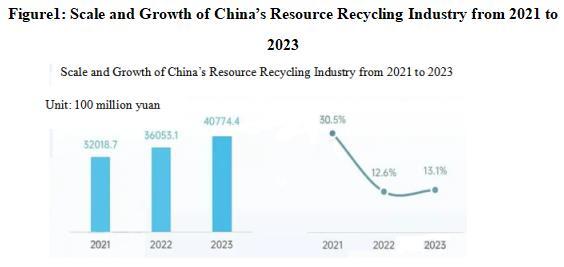
In 2023, the scale of China’s renewable resource recycling industry reached 1.6697 trillion yuan, accounting for 40.9%, making it the largest proportion in China’s resource recycling industry. The comprehensive utilization scale of industrial solid waste followed closely behind, with an industrial scale of 1.21514 trillion yuan, accounting for 29.8%.
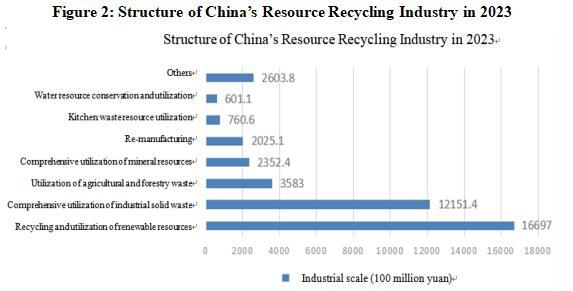
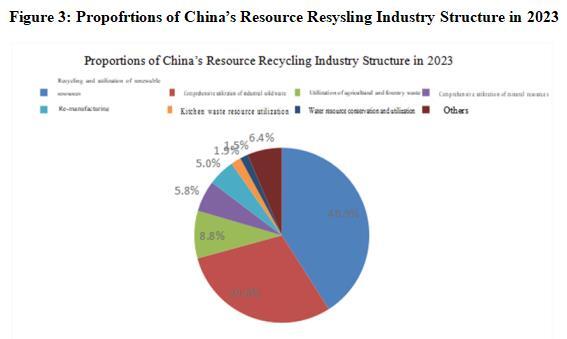
With policy support, improving the resource recycling system and perfecting the network for recycling waste materials have become key tasks for industrial development. With the stable increase in the scale of renewable resource recycling in recent years, the total amount of renewable resource recycling in China reached 590 million tons in 2023, a year-on-year increase of 13.5%.
The country has accelerated the nationwide distribution of various resource recovery service outlets, and the scale of recovery has gradually grown. The recycling network system of “collection, transportation, storage, treatment and comprehensive utilization” has become more and more perfect, bringing together professional recycling service outlets with recycling, storage and transportation qualifications throughout the country, and forming an integrated resource recovery network system with Internet technology application as the center, data sharing and information circulation.
In the various sub sectors of renewable resource recycling and utilization, retired photovoltaic, wind power equipment, and power batteries have become important areas of concern in the industry. The market size and technological development in the field of renewable resource recycling and utilization, represented by collection, transportation, operation services, equipment manufacturing, etc., will enter an explosive period in the next 3-5 years, which is a good opportunity for investment institutions to enter.
With the gradual construction of a global green and low-carbon recycling system, the market space for waste resources in foreign countries is constantly being released. Enterprises will expand their business layout and build renewable resource recycling production lines abroad, forming a foreign development model for renewable resource recycling and accelerating its extension to the global market.
In recent years, China has accelerated the adjustment of its energy structure and industrial structure. The production scale of traditional raw material industries such as coal, steel, building materials, non-ferrous metals, and petrochemicals has been decreasing year by year. On the other hand, with the increasing emphasis on environmental protection, the production technology of enterprises has been continuously optimized, production efficiency has been improved, and the amount of solid waste generated has also been reduced to a certain extent. In 2023, the amount of general industrial solid waste generated in China decreased to 1.17 billion tons, a year-on-year decrease of 2.4%.
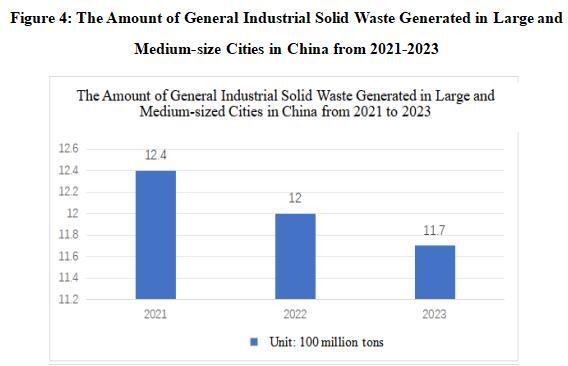
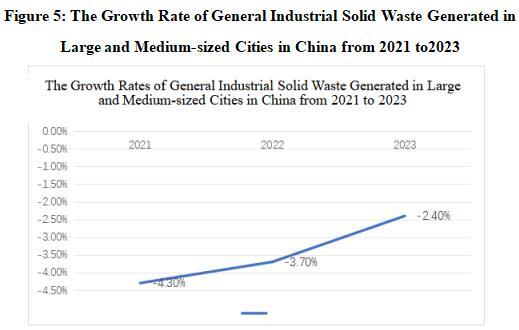
During the 14th Five-Year Plan, the country has accelerated the pilot construction of “waste-free cities”. The pilot cities are guided by the new development concept of innovation, coordination, green, openness, and sharing. By promoting the formation of green development and lifestyle, they continue to promote the reduction and resource utilization of solid waste sources, minimize landfill volume, and form an urban development model that minimizes the environmental impact of solid waste.
With the increasing awareness of environmental protection and the demand for resource utilization, the comprehensive utilization of industrial solid waste is developing towards a more efficient and environmentally friendly direction. Through technological innovation, industrial solid waste can be converted into reusable resources or energy such as fertilizers and building materials.
(2) Industrial trends of circular economy industrial parks
With the increasing global emphasis on resource conservation and environmental protection, the market demand for circular economy industrial parks is growing day by day. The circular economy industrial park has become an important model for promoting sustainable economic development through efficient resource utilization, waste reduction, and resource utilization. In terms of market size, the circular economy industrial park is growing rapidly and is expected to maintain strong growth momentum in the coming years, especially in the fields of resource recycling and reuse, where there is huge market demand.
At present, the market of China’s circular economy industrial parks is showing strong vitality. Data shows that the value of renewable resource recycling continues to rise, and the comprehensive utilization of bulk solid waste is expected to reach a significant level. The power generation from biomass waste is also expected to increase significantly. In terms of policies, the government attaches great importance to the development of circular economy and has introduced a series of supportive policies, providing strong guarantees for the development of the industry. Market forecasts show that circular economy industrial parks will continue to expand in size in the coming years and become an important force in promoting green transformation.
In terms of the market competition pattern, the circular economy industrial park industry is facing a situation of diverse enterprise types and complex competition pattern. There are both companies in the market that focus on technological innovation, companies that emphasize marketing and price competition, and companies that simultaneously focus on technology, marketing, pricing, and services. This diversified competitive landscape makes market competition fierce and complex.
At the same time, the development of the circular economy industrial park industry is also influenced by various factors such as policy support, technological innovation, and market demand. With the increasingly serious global environmental problems and consumers' increasing awareness of environmental protection, the demand for circular economy industrial parks continues to grow, providing a broad market space for industry development. However, the circular economy industrial park industry also faces some challenges in its development process, such as incomplete market structure and insufficient policy support. In order to promote the sustained and healthy development of the industry, it is necessary to further improve the market structure, strengthen policy support, and promote technological innovation and industrial upgrading.
The industrial chain of circular economy industrial parks is an industry with broad development prospects and market competitiveness. In the future, with the continuous advancement of technology and the expansion of the market, this industry is expected to play a more important role in the sustainable development of the global economy.
(3) Current situation of Jilin Province
In June, 2024, Jilin Province issued and implemented the Measures on Strengthening Ecological Environment Zoning Control, dividing the province into 1233 environmental control units and implementing differentiated zoning control. Next, Jilin Provincial Department of Ecology and Environment will highlight precise control, continue to promote industrial ecology and ecological industrialization, and enable “beautiful appearance” to produce “golden values”.
Jilin Province will promote the construction of “waste-free cities” in the whole region with the main goals of “significantly reducing the intensity of solid waste generation in various regions, significantly improving the level of comprehensive utilization, improving the governance system, and significantly enhancing the ability of information supervision”.
In recent years, Jilin Province has promoted the joint construction of Changchun City and Jilin City, exploring and launching the integrated construction of “zero waste city” in each city (prefecture). Around the Seven Major Projects, it plans to promote 257 “waste-free city” construction projects with a total investment of 85.036 billion yuan. Currently, 200 projects have started construction and 146 have been completed. Construct 913 types of “waste free cells”, forming a good situation of comprehensive “waste free city” construction from few to many, from point to surface. Establish a provincial-level “zero waste city” expert database to provide full process tracking guidance and assistance. Coordinate 12 financial institutions to compile the Financial Support Manual and create “Jilin Financial Supermarket” to solve problems such as “difficult financing” and “expensive financing”, etc. Next, Jilin Provincial Department of Ecology and Environment will anchor the goal of building “zero waste cities” throughout the region, and promote the acceleration of the construction of “zero waste cities” in the entire region to enter the “fast lane” and step onto a “new level”.
1.1.3 Technical analysis
The specific methods for recycling scrap metals include the following:
Recycling and reuse: By recycling and classifying metal waste, and then using waste metal processing equipment for decomposition, transformation, and reprocessing, it becomes new raw materials or products.
Physical processing method: Using mechanical crushing, magnetic separation and other methods to separate different types of metals and other materials from waste metal, achieving effective recycling and utilization.
Chemical treatment method: For some waste metals that are difficult to treat by the physical method, they are extracted from waste metals through dissolution, electrolysis, and other methods, usually used for the extraction of precious metals.
Biological treatment method: With the microbial bio metallurgical technology used, waste metals are extracted from waste materials through the metabolic process of microorganisms.
Heat treatment method: including high-temperature incineration and pyrolysis, suitable for processing waste metals wrapped in plastics and rubber.
1.1.4 Advantageous conditions of project construction
(1) Policy advantages
In 2021, the National Development and Reform Commission issued the 14th Five-Year Plan for the Development of Circular Economy (hereinafter referred to as the Plan). The Plan proposes that by 2025, circular production methods will have been fully implemented, green design and clean production will have been widely promoted, the comprehensive utilization capacity of resources will have been significantly improved, and a resource circular industrial system will have been basically established. The recycling network for waste materials has become more complete, the ability to recycle renewable resources has been further enhanced, and a resource recycling system covering the entire society has been basically established. The efficiency of resource utilization has significantly improved, and the proportion of renewable resources replacing primary resources has further increased. The supporting and guaranteeing role of circular economy in resource security has become more prominent.
In January, 2022, the National Development and Reform Commission and other departments issued the Guiding Opinions on Accelerating the Construction of Waste Resource Utilization System, proposing that by 2025, the policy system for recycling waste materials should have been further improved, and the level of resource recycling should have been further enhanced. The network system for recycling waste materials has been basically established, and more than 1000 green sorting centers have been built. The “scattered pollution” situation in the renewable resource processing and utilization industry has significantly improved, with a significant increase in agglomeration, scale, standardization, and informatization levels. The recycling amount of 9 major renewable resources, including scrap steel, scrap copper, scrap aluminum, scrap lead, scrap zinc, waste paper, waste plastics, waste rubber, and waste glass, has reached 450 million tons. The circulation order and transaction behavior of second-hand goods have become more standardized, and the transaction scale has significantly increased. About 60 large and medium-sized cities have taken the lead in establishing a basic and complete waste material recycling system.
In 2023, the Ministry of Industry and Information Technology and three other departments jointly issued the National Catalogue of Advanced Applicable Process Technology and Equipment for Comprehensive Utilization of Industrial Resources (2023 Edition), proposing to further accelerate the promotion and application of advanced applicable technology and equipment from the aspects of industrial solid waste reduction, comprehensive utilization of industrial solid waste, recycling and utilization of renewable resources, and re-manufacturing, continuously improve the efficiency and level of resource recycling, and promote the sustainable innovation and development of China’s resource recycling industry.
The 14th Five-Year Plan for the construction of “waste free cities” in Jilin Province proposes to promote the construction of “urban mineral” bases. Accelerate the construction of a recycling system for waste materials, promote the integration of garbage classification and transportation with the recycling of renewable resources, and promote the recycling of low value recyclable materials such as glass. Coordinate the planning and layout of renewable resource processing and utilization bases and regional trading centers, support leading enterprises such as metal smelting, papermaking, and automobile manufacturing to cooperate with renewable resource recycling and processing enterprises, and build integrated green sorting, processing, and distribution centers for scrap steel, scrap non-ferrous metals, waste paper, and other waste materials. Promote the agglomeration and development of the renewable resources industry, and encourage small and micro enterprises in the field of renewable resources to enter parks and districts. Priority should be given to supporting renewable resource recycling enterprises with strong comprehensive strength and good business reputation, building demonstration projects for renewable resource recycling and utilization systems, and actively cultivating provincial-level demonstration enterprises for renewable resource brand recycling. Build demonstration projects for electronic waste recycling, utilization, and disposal based on disposal enterprises. Build a demonstration project of harmless treatment of white foam plastics. Build a demonstration project for the reuse of scrap steel with a focus on hardware manufacturing plants, foundries, and blast furnace steel mills.
In the Implementation Opinions of Jilin Provincial Department of Finance on Supporting Green and Low Carbon Development and Promoting Carbon Peak and Carbon Neutrality in 2023, it is required to support the development of circular economy, promote the circular development of industrial parks, strengthen the comprehensive utilization of bulk solid waste, improve the recycling system of waste materials, and promote the reduction and resource utilization of household waste. Support the recycling and disposal of discarded electrical and electronic products. Support the promotion of a comprehensive utilization model of straw based on conservation tillage, and carry out the resource utilization of livestock and poultry manure and the recycling of plastic film. Support the construction of “zero waste cities” across the entire region, and comprehensively improve the level of urban development and solid waste management.
The Investment Promotion Policy of Jilin City specifies that the investment projects of Jilin City’s Industrial Investment Guidance Fund should comply with national and relevant industrial policies and development plans, with a focus on investing in tourism, medicine and health, aviation, information technology, new materials, advanced equipment manufacturing, biotechnology, energy conservation and environmental protection, new energy, cultural creativity, modern agriculture, modern service industry and other related industries in Jilin City’s “6411” industrial plan, as well as other areas supported by the municipal government for development. Guiding funds can adopt investment methods such as follow-up investment and direct investment, in addition to setting up sub funds through equity participation; newly introduced investment projects that meet the conditions shall enjoy tax reductions and exemptions in accordance with the current national and provincial tax policies. For projects with a significant contribution rate in Jilin City, in accordance with the spirit of the Notice of the State Council on Relevant Matters Concerning Tax Preferential Policies (GF [2015] No. 25), relevant departments shall assist enterprises in applying for tax exemptions and reductions in accordance with the law and regulations; Establish a special fund for the development of industrial enterprises, and encourage the introduction of major projects in traditional industries such as chemical, automotive, metallurgical, and agricultural product processing in the “6411” industrial system that comply with national industrial policies, have strong industrial support, and have a significant driving effect; Encourage the introduction of emerging industries such as medicine and health, new materials, advanced equipment manufacturing, and electronic information. Give priority to the allocation of production factors and recommend relevant national and provincial special funds for support.
(2) Resource advantages
Jilin City has great potential for the development of resources such as hydropower, wind energy, solar energy, biomass energy, and oil shale. Jilin City has developed water systems and abundant hydropower resources, consisting of some sections and tributaries of the Songhua River, Lalin River, and Mudanjiang River systems. The annual available water resources are 17 billion cubic meters, and the per capita water resources are 1.8 times the national average and 5.4 times that of northern cities. It can fully develop hydropower projects and has the conditions to build large-scale pumped storage power stations. The equivalent full load on grid hours of wind power in various regions mainly range from 2000 hours to 3300 hours. Jilin City is located in the central part of Jilin Province, with a total solar radiation of 4800-5000 megajoules per square meter, and the radiation levels in various regions of the city are basically the same. The annual sunshine distribution is basically consistent with the distribution of solar radiation, with an average annual power generation hours of 1320 hours. Jilin City is an important grain production base in the province, with abundant resources of crop straw and forestry processing residues, and superior conditions for biomass energy utilization. Among them, the annual output of agricultural straw resources is 6.53 million tons, and the annual output of forestry resources is 1.5 million tons, both of which can be used for the development of biomass energy. The Songhua River Basin has abundant water resources and stable regional seismic and engineering geological conditions, providing favorable conditions for the development of nuclear energy. In the early stage, nuclear power construction sites of the project have been carried out at Liangjia Mountain, Shulan, Songjiang, Jiaohe and Dianjiangtai, Huadian. At the same time, research has been conducted on promoting nuclear heating small reactor projects, which has a certain foundation for the development of nuclear energy resources.
The installed capacity of power sources in the city is 10 million kilowatts, with an additional 3.279 million kilowatts added during the 14th Five-Year Plan period, an average annual growth rate of 8.3%. Among them, coal-fired power generation accounts for 3.07 million kilowatts, accounting for 30.7%; gas power generation of 860000 kilowatts, accounting for 8.6%; wind power is 1.54 million kilowatts, accounting for 15.4%; photovoltaic power generation of 700000 kilowatts, accounting for 7%; 3.5 million kilowatts of hydropower (3.2 million kilowatts of conventional hydropower and 300000 kilowatts of pumped storage), accounting for 35%; 270000 kilowatts of biomass power generation, accounting for 2.7%; waste to energy generation accounts for 58000 kilowatts, accounting for 0.6% of the total installed capacity, while new and renewable energy installations account for 60.7% of the total installed capacity. It is expected that by 2025, the power generation will have reached 20.63 billion kilowatt hours, and the total transformer capacity of urban and rural power grids will have reached 4891.1 megavolt amperes.
The administrative jurisdiction area of Jilin New and High-tech Industrial Development Zone is nearly 130 square kilometers (consisting of New and High-tech South Branch, New and High-tech North Branch, Jiangbei Fine Chemical Industrial Park, and Xiushui Industrial Park).
Jilin New and High-tech Zone has a large stock of exploitable land resources, and newly added and reserved land can meet the needs of new projects. Land prices are at a low level among 41 cities in Northeast China.
(3) Industrial advantages
Jilin New and High-tech Zone currently has over 5000 industrial and commercial enterprises of various types, including more than 170 “four-superior-aspect” enterprises, over 140 high-tech enterprises, “specialized, refined, special and new” enterprises, and technology-based small and medium-sized enterprises. It also has 10 technology enterprise incubators and 5 maker spaces, making it a national demonstration base for mass entrepreneurship and innovation.
In the face of future development, Jilin New and High-tech Zone adheres to the guidance of Xi Jinping Thought on Socialism with Chinese Characteristics for a New Era, faithfully practices the important instructions of General Secretary Xi Jinping’s inspection of Jilin, adheres to the principle of “optimizing the south and revitalizing the north while being high and new”, implements the “435"" development strategy (strengthening the four leading industries of “automobile and parts, electronic information, medicine and health, and equipment manufacturing”; cultivating the three major industrial clusters of “big equipment, big medicine, and big data”; forming the industrial scale of a “50 billion-level development zone”), cultivates new quality productive forces, leads new industrialization, builds benchmark areas for innovation, economic vitality, ecological vitality, and social vitality, creates a highland for the development of new industries and a high-quality development engine, and constructs the New and High-tech Zone in a new era with both form and spirit in high spirits.
There are numerous industrial enterprises in the region. In 2023, the amount of hazardous waste generated in Jilin City was 1.396 million tons, accounting for 46% of the province’s total; the amount of general industrial solid waste generated exceeds 13.8238 million tons. The upstream materials of the project can cooperate with local raw material enterprises to ensure the improvement of the circular economy industry chain and the supply of raw materials.
(4) Talent advantages
Jilin City has universities such as Northeast Electric Power University, Jilin Institute of Chemical Technology, Beihua University, Jilin Agricultural Science and Technology College, Jilin Medical College, Jilin Electronic Information Vocational and Technical College, Jilin Industrial Vocational and Technical College, Jilin Railway Vocational and Technical College, Jilin General Aviation Vocational and Technical College, etc. These universities offer relevant majors, providing a continuous supply of talent support for production enterprises.
At the same time, Jilin City has a large number of high-quality industrial and chemical workers. After training by enterprises and public welfare institutions, more than 10000 skilled talents are sent to the society every year, and more than 20000 people of various types are trained for the society. The labor resource advantages are obvious, and the proportion of skilled workers is at a high level in the Northeast urban agglomeration. The labor force is in a dividend period, and the labor cost is relatively low. There is a large number of high-quality industrial workers who can meet the needs of various enterprises.
(5) Location and transportation advantages
Jilin New and High-tech Zone has obvious location advantages and is one of the core areas of Changchun-Jilin-Tumen Opening-up Pilot Zone constructed by Jilin Province. The transportation is convenient, with fast railway, highway, and air transportation. It is only 5 kilometers away from Jilin Railway Station and can be connected to China’s highway network through the Ring Expressway. It is 68 kilometers away from Changchun Longjia International Airport. The area is densely populated with higher education institutions and research institutions, rich in intellectual resources, rich in entrepreneurial culture, and developed service industries, making it suitable for innovation and entrepreneurship.
1.2 Contents and scale of project construction
1.2.1 Construction scale
The project covers an area of 1 million square meters and achieves an annual increase in solid waste treatment capacity of over 5 million tons.
1.2.2 Construction contents
The total construction area of the project is 1.1 million square meters, mainly including the construction of a renewable resources center, a recycling center, a raw material warehouse, a dismantling center, a re-manufacturing center, an energy conservation and environmental protection center, a new energy service center, a big data center, a carbon trading center, and supporting facilities.
1.3 Total investment of the project and capital raising
1.3.1 Total investment of the project
The total investment of the project is 10 billion yuan, including the construction investment of 7.7 billion yuan and current funds of 2.3 billion yuan.
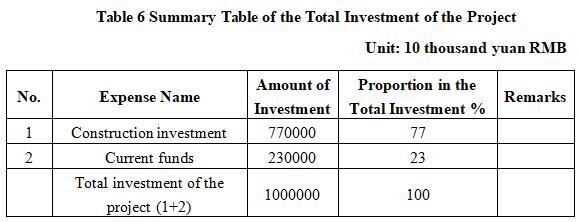
1.3.2 Capital raising
Self-raising by the enterprise
1.4 Financial analysis and social evaluation
1.4.1 Main financial indexes
After the project reaches the production capacity, its annual sales revenue will be 10.04915 billion yuan, its profit will be 2.11864 billion yuan, its investment payback period will be 7.9 years (after the tax, including the construction period of 2 years) and its return on investment will be 21%.
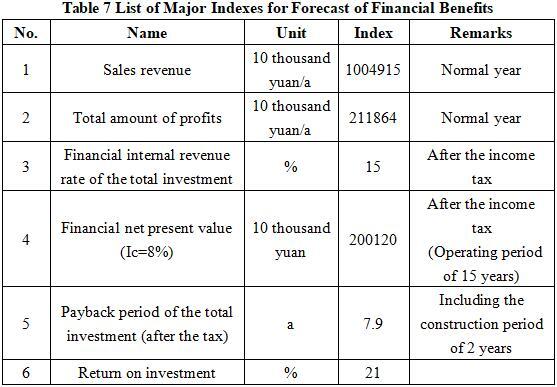
Note: “10 thousand yuan” in the table is in RMB.
1.4.2 Social evaluation
The project will cooperate with domestic industrial technology enterprises, and in the construction and operation of the industrial park, by adopting advanced energy-saving technologies and circular economy models, it can significantly improve energy utilization efficiency and resource recovery utilization rate. This can not only significantly reduce the energy consumption and operating costs of enterprises, but also reduce excessive exploitation and dependence on natural resources, thereby protecting the ecological environment and achieving coordinated development of the economy, society, and environment.
The construction of this industrial park will further promote Jilin City’s exploration and innovation in the field of green and low-carbon, leading and driving more enterprises and parks towards the path of green and low-carbon development.
1.5 Cooperative way
Joint venture or cooperation, other methods can be discussed face-to-face.
1.6 What to be invested by the foreign party
Funds, and other methods can be discussed face-to-face.
1.7 Construction site of the project
Jilin New and High-tech Industrial Development Zone
1.8 Progress of the project
It is attracting foreign investment.
2. Introduction to the Partner
2.1 Basic information
Name: Management Committee of Jilin New and High-tech Industrial Development Zone
Address: Jilin New and High-tech Industrial Development Zone
2.2 Overview
Jilin New and High-tech Industrial Development Zone was approved by the State Council as a national high-tech zone in November, 1992. After more than 30 years of development and construction, it has now developed into an ecological new urban area with a good industrial foundation, strong innovation ability, and beautiful livable and business environment. It has won honors such as National Advanced New and High-tech Zone and National Torch Plan Advanced Unit.
Jilin New and High-tech Zone currently has a jurisdictional area of nearly 130 square kilometers, consisting of parts such as the New and High-tech South Branch and the New and High-tech North Branch, presenting a coordinated development pattern of the north and south wings.
In the first half of 2024, the gross domestic product of the entire region was 4.1 billion yuan, an increase of 10.5%, 3.6 percentage points higher than the city, ranking second in the city in terms of growth rate, fully demonstrating the good momentum of the development of Jilin New and High-tech Zone. In the future, it will take the development of new quality productivity as the driving force and accelerate the reshaping of the billion dollar industrial system. Relying on industrial foundation and resource endowment, it will accelerate the construction of a “3+1” modern industrial system. Focusing on the fields of automobiles and their components, ice and snow tourism equipment, and specialized complete sets of equipment, it aims to build a billion-dollar industrial cluster for equipment manufacturing.
2.3 Contact method
Postal code: 132000
Contact person: Wang Ziming
Tel: +86-15688990008
E-mail: 67980967@qq.com
Contact method of the city (prefecture) where the project is located:
Contact unit: Investment Promotion Service Center of Jilin Bureau of Commerce
Contact person: Jiang Yuxiu
Tel: +86-432-62049694
+86-15804325460
E-mail: jlstzcjfwzx@163.com


